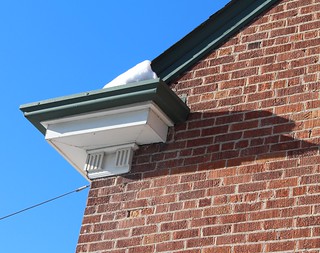
Place: Winnipeg Electric Co. Substation
Address: 265 Osborne Street at Jessie Avenue (Map)
Opened: 1947
Architect: Unknown
Contractor: Unknown
November 21, 1938, Winnipeg Tribune
Until 1953 Winnipeg's public transportation system was operated by a private company. In the 1940a it was known as the Winnipeg Electric Company, (WECo).
To get Winnipeggers around town, they used a combination of streetcars, motorized buses and, starting in 1938, trolley buses. These vehicles were a hybrid of the two modes, using rubber-tired buses that ran on electricity from overhead wires.
To get Winnipeggers around town, they used a combination of streetcars, motorized buses and, starting in 1938, trolley buses. These vehicles were a hybrid of the two modes, using rubber-tired buses that ran on electricity from overhead wires.
Investment in public transit ground to a halt during World War II as vehicle and parts manufactures were converted over to wartime production. Following the war, public transit systems had to play catch-up for those lost years plus expand new service further into the city's suburbs.
In order to power a trolley bus line there had to be a direct current substation, also called a rectifier, somewhere along the route. The first four substations proposed in 1946 were for the north-east corner of Stafford Avenue at Kingsway Crescent, Academy Road at Harrow Street, Osborne Street at Jessie Avenue and on McGregor Avenue.
The Stafford Avenue substation was the first to go before a city rezoning meeting. Dozens of residents showed up to protest the creation of an "industrial site" on their residential street.

The Osborne substation sat vacant until 1972. That was the year Unicity was created and the newly formed Fort Rouge Community Committee needed a place to meet. The city studied a number of sites and chose to convert this to office space. The first committee meeting was held here in September 1972.
By 1978 a more permanent home was found for the community committee and the building became home to the Regional Recreational Services branch of the city. From the late 1980s to 2014 it was home to the General Council of Winnipeg Community Clubs, (GWCC).
In 2013 the city voted to remove the building from its Inventory of Historical Buildings (it had a Grade III status) and declare the land surplus so that it could be sold.
In January 2016 construction began on phase one of Osborne Place, a six-storey, 32,000 square foot office development. Phase two of the project, expected to start construction in 2017, will involve the demolition of 265 Osborne Street for a 10 - 12 storey residential tower.
January 29, 1947, Winnipeg Tribune
In order to power a trolley bus line there had to be a direct current substation, also called a rectifier, somewhere along the route. The first four substations proposed in 1946 were for the north-east corner of Stafford Avenue at Kingsway Crescent, Academy Road at Harrow Street, Osborne Street at Jessie Avenue and on McGregor Avenue.
The Stafford Avenue substation was the first to go before a city rezoning meeting. Dozens of residents showed up to protest the creation of an "industrial site" on their residential street.

The WECo's J. E. Wilson represented the company at the hearing and showed off their design plans. It would be " ... a brick, Georgian-style building, porticoed, and designed to look like a library". The giant heat exchangers would be disguised as dual chimneys and the lot landscaped to fit in with surrounding properties.
The "Georgian library" model was also proposed for 265 Osborne Street. The one for the south-west corner of Academy Road at Harrow Street was designed to look like a bungalow.
Due to citizen opposition and delays getting equipment, it took until spring 1947 for construction to get started. By October Osborne's 1,166 square foot building with full basement was in service.
September 15, 1972, Winnipeg Free Press
Trolley bus service came to an end on Friday October 30, 1970, making the substations redundant. Some were torn down, the one at 216 Academy Road at Harrow Street was converted into a residence.
By 1978 a more permanent home was found for the community committee and the building became home to the Regional Recreational Services branch of the city. From the late 1980s to 2014 it was home to the General Council of Winnipeg Community Clubs, (GWCC).
Osborne Place, 257 Osborne (source)
In 2013 the city voted to remove the building from its Inventory of Historical Buildings (it had a Grade III status) and declare the land surplus so that it could be sold.
In January 2016 construction began on phase one of Osborne Place, a six-storey, 32,000 square foot office development. Phase two of the project, expected to start construction in 2017, will involve the demolition of 265 Osborne Street for a 10 - 12 storey residential tower.
Related:
Historic Buildings Committee Report
My photo album of 265 Osborne
Osborne Place at the Station promotional video Imperial Properties
Historic Buildings Committee Report
My photo album of 265 Osborne
Osborne Place at the Station promotional video Imperial Properties



Did they build the Stafford one?
ReplyDeleteDid they build the Stafford one?
ReplyDeleteWell, did they? Please answer!
ReplyDelete